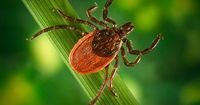In recent years, the United States has witnessed a striking surge in tick-borne diseases, with new research and mounting veterinary data shining an urgent spotlight on the risks facing both people and animals. From the forests of the Northeast to the beaches of California, scientists and public health officials are warning that the landscape of tick-borne infections is rapidly changing, fueled by ecological shifts, climate change, and the relentless adaptability of parasites. At the heart of this story are two diseases—babesiosis and anaplasmosis—that, while once considered rare or regional, are now spreading fast, demanding new tools for detection and a fresh look at how we monitor their advance.
On August 18, 2025, researchers at Carnegie Mellon University announced a breakthrough in the fight against babesiosis, an infectious disease that, according to reporting by Carnegie Mellon University Chemical Engineering, manifests with malaria-like symptoms and spreads in a manner reminiscent of Lyme disease. Once a rarity in the United States, babesiosis is now increasingly common, especially in the Northeast, Mid-Atlantic, and Upper Midwest. The culprit is the parasite Babesia microti, which lives in the blood of rodents and is transmitted to humans via tick bites. Once inside the bloodstream, the parasite invades and damages red blood cells, sometimes causing severe flu-like symptoms—particularly in older adults and those with compromised immune systems. Yet, the mechanisms by which Babesia microti infects and spreads remain murky, complicating efforts to diagnose and treat the disease early.
Seeking to shed light on these mysteries, Tagbo Niepa, associate professor of chemical engineering and biomedical engineering at Carnegie Mellon, and his team developed a new microfluidic platform designed to mimic the blood microenvironment and allow scientists to observe the infection dynamics of Babesia microti in real time. “We wanted to make a tool in which the parasite can reside and remain viable, so that it can be studied in vitro,” Niepa explained to Advanced Science. Traditional research methods have relied heavily on animal models, but cultivating parasites outside a living host has long posed a challenge. The Niepa μBiointerface Lab’s innovation lies in its ability to maintain whole blood conditions within a microscopic channel—just big enough for a single layer of red blood cells—so researchers can watch the parasite at work, cell by cell.
This new platform, detailed in the journal Advanced Science in 2025, offers several advantages over previous methods. By functionalizing the hydrophobic and hydrophilic properties of surfaces and precisely placing oil and water, the team can fabricate channels that replicate the natural environment of red blood cells. The open microfluidic system provides superior physical and optical access compared to closed systems, enabling scientists to use confocal microscopy to capture high-resolution images of Babesia microti—which have been specially stained to fluoresce for easy identification. This allows researchers to measure parasite density, monitor damage to infected red blood cells, and track the progression of infection over time.
“You can observe the monolayer of cells and see the infection dynamics of Babesia over time,” Niepa noted. The platform’s design not only makes it easier to spot the parasite but also opens the door to automated device operation and AI-powered image analysis—potentially transforming how quickly and accurately infections can be detected. While current hospital tests for babesiosis are quick and inexpensive, they lack the depth of information this new system can provide. Niepa envisions a future where artificial intelligence streamlines the advanced imaging process, delivering richer data to clinicians and researchers alike.
There’s much more to unravel, though. For example, while Babesia microti infects rodents and humans, deer—often responsible for spreading ticks—do not become infected themselves. “This comes with some interesting biological questions that will be easier to study in our in vitro platform than in animal models,” Niepa said. In its current form, the system can maintain viable blood samples for 72 hours, but the lab is working on enhancements to extend this window to a full week, surpassing existing technologies.
While scientific advances are helping decode the mysteries of tick-borne diseases in the lab, public health officials in California are grappling with a different set of challenges. According to a report published on August 18, 2025, by the Los Angeles Times, the rate of California dogs testing positive for exposure to the bacterium that causes anaplasmosis nearly tripled between 2021 and 2024. Anaplasmosis, like Lyme disease, is spread by the western blacklegged tick—and experts say the sharp rise in canine cases serves as a warning for humans. “It’s a canary in the coal mine,” said Brad Ryan, a veterinarian at Antech Diagnostics. “When the prevalence starts to go up in the animal population, we know that the public health risk has, by default, also gone up.”
Dogs, it turns out, are particularly useful sentinels for tracking vector-borne diseases. They receive more tick bites than people and are tested more frequently, providing an early indicator of human risk. The data is sobering: more than half of California’s counties are now considered high infection risk for tick-borne diseases. In Los Angeles County, the percentage of dogs testing positive for anaplasmosis more than doubled in five years, rising from 0.5% to 1.2%. Yet, the Companion Animal Parasite Council, which tracks these numbers, believes their figures may actually underestimate the true scale of the problem, capturing only about 30% of actual parasite activity in any given region.
Climate change is a major driver behind the spread of these diseases, as warming temperatures allow ticks to expand into new territories and extend their active seasons. In California’s temperate climate, the risk is now year-round, with western blacklegged ticks migrating into Southern California and brown dog ticks moving north from Mexico. While the prevalence of anaplasmosis in Southern California dogs remains lower than in some northern hotspots, experts warn that the risk is real and growing. “Anaplasmosis is not just an East Coast problem; it’s very much here in California,” said Dr. Sunjya Schweig, founder of the California Center for Functional Medicine. He added, “Unfortunately, the doctors don’t always recognize that, so it’s really hard sometimes for people to get the right care.”
Human cases of anaplasmosis in California have also doubled between 2020 and 2021 and remained elevated through 2023, with 21 cases reported last year, including eight from Los Angeles County. Most were linked to travel to Northern California or other parts of the U.S., but local factors—such as urban development encroaching on wildlife habitats—are helping ticks and their hosts thrive in suburban landscapes. The situation is further complicated by disagreements within the medical community over testing and treatment protocols. “There is a big problem. It’s much more common than we know. The tests are crummy. There’s a lot of sick people who aren’t being diagnosed,” Schweig said, describing a “religious battle” between mainstream medical organizations and those pushing for broader recognition of tick-borne illnesses.
Preventing tick bites remains the first line of defense for both people and pets. Experts recommend wearing long pants and sleeves, using tick repellents, and checking for ticks after spending time in grassy or wooded areas—especially during the spring and fall, when tick activity peaks. For dog owners, year-round flea, tick, and heartworm prevention is advised, along with regular screening for vector-borne diseases during annual veterinary visits.
As tick-borne diseases continue to spread and evolve, the combined efforts of researchers, veterinarians, and public health officials are more important than ever. With new technologies emerging and awareness on the rise, the hope is that early detection and better understanding will help curb the impact of these persistent threats.




